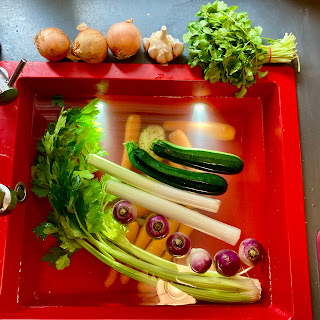For Janet 😉
Here is my take on a classic (at least here in France) almost as popular as the bolognese sauce version. I followed a recipe but I also improvised so this will help me remember what I did before I forget. And it tasted better than all the spinach lasagna that I ever bought in delis.
Ingredients
For six. Divide the quantities accordingly
- lots of spinach!
- fresh tarragon leaves
- chives
- parsley
- pre-cooked lasagna sheets. I bought two boxes in case I wouldn't have enough and ended up using like one third of a box
- 3 shallots
- 10 button mushrooms
- butter (lots!)
- 800g of shrips (500g if they are already shelled)
- 400g of salmon filets
- salt, black pepper, nutmeg
for the white sauce
- butter 200g
- flour 100g
- whole milk 1.5l
- Gruyère cheese shredded
- Roquefort or whichever blue cheese you can put your hands on
- salt, black pepper, nutmeg
Preparation
Cut the shallots thinly. Sauté them in a mix of butter and olive oil for 15min in a big pan on low heat (a wok with a lid will be perfect)
Add half a glass of water
Add the spinach leaves after removing the stems, washing them several times and cutting them in three. Wait until the leaves shrivel (a few minutes will be enough). Add the rest of the leaves if there were too many of them. Add the chopped fresh parsley, chives and tarragon leaves. Cook for a few more minutes. Add nutmeg, ground black pepper and salt to taste.
Reserve in a big bowl, drain and keep the juice.
In the same pan, add more butter and olive oil and sauté the mushroom that have been cut in thick slices on high heat for a few minutes. Add them to the spinach.
The Sauce Mornay:
Heat 200 g of butter on medium heat and when it starts to bubble, add 100g of flour. Stir continuously for 2 minutes. Add progressively 1.5l of milk. Stir until the sauce thicken. It will take 5 to 10 minutes. Do not use high heat or the sauce might burn at the bottom of the pan. Add nutmeg, ground black pepper and salt. When it is thick enough add 150g of blue cheese or Roquefort, 500g of shredded Gruyere. Stir until all the cheese is melted. I was left with a small quantity of sauce in the end but it's better than not having enough of it. Which more or less defines my philosophy concerning cooking. And life in general 😁
Final phase:
Assembling and cooking the lasagna
Shell the shrimps if they are whole. Cut slices of salmon from the fillets.
Place your sheets of lasagna at the bottom of a buttered baking dish and cover the surface with them. No problem if they overlap a bit. Pour half a ladle of the spinach juice on them. Add a layer of spinach/mushroom mix, cover with the slices of salmon then a layer of white sauce.
Add another layer of lasagna, half a ladle of spinach juice, the spinach/mushroom mix, the shrips, more white sauce.
Add the last layer of lasagna. Cover with white sauce.
Put in pre-heated 160C/320F oven fo 40 minutes. I used a tray under the baking dish because I knew it would overflow a little. And it did!
Raise to temperature of your oven to 200C/392F and cook an additional 10 minutes for a nice brown appetising look. You can all use the grill to achieve that.
Allow the baking dish to cool for half an hour. Serve and enjoy...









































